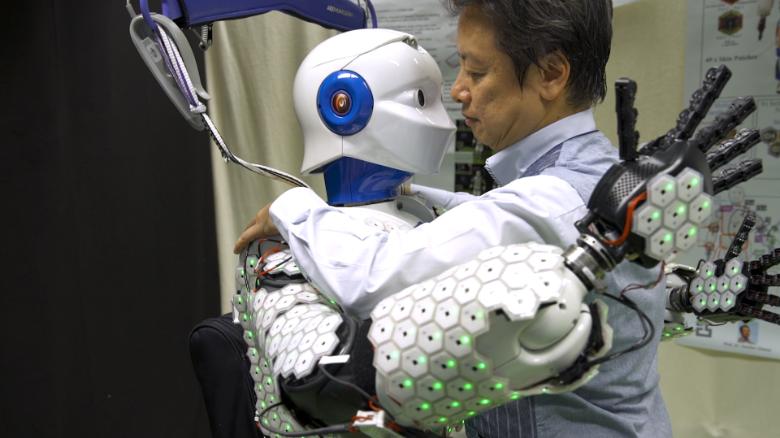The artificial skin that allows robots to feel

Scientists last month unveiled an artificial skin that enables robots to feel and respond to physical contact, a skill that will be needed as they come in increasingly close contact with people.In 2017, manufacturers worldwide used roughly 85 industrial robots per 10,000 employees, according to a report by the International Federation of Robotics. The same report predicts the global supply of industrial robots to grow 14% per year until 2021. But if robots end up working more closely with their fleshy colleagues, one concern is how they will interact safely.”Currently, robots do not have any sense of touch,” Professor Gordon Cheng, who developed the special skin with his team at the Technical University of Munich, tells CNN Business. Robots are able to exert forces that could seriously injure a human being, so employers need to ensure they are aware of their surroundings and able to navigate around people. “Touch enables safe robot operation, by detecting contact with unseen obstacles and giving the possibility to apply the correct force for achieving a task, without damaging objects, people and the robot itself,” Chiara Bartolozzi, a robotics expert at the Italian Institute of Technology, independent of the research, tells CNN Business. Not only could this special skin make collaboration between humans and robots safer, it could also enable the future of robots as caregivers, health workers and companions. Mimicking human skinTo develop the synthetic skin, the researchers began by studying humans.Each person has about 5 million skin receptors that register what’s happening on the body’s surface and send signals to the brain. But the brain can’t digest information from each one at the same time. Instead, the nervous system prioritizes new sensations. Mimicking this, the team covered a human-size autonomous robot (known as H-1) with more than 13,000 sensors from shoulder to toe, that are able to detect temperature, acceleration, proximity and pressure.”These [factors] are fundamental to sense in humans… [they] are what make interactions between human and human very safe,” says Cheng.The team is currently working on creating smaller sensor cells that could be produced in bulk.Some scientists are skeptical of its scalability. The high cost of each sensor and its fragility is a major barrier for mass production, Etienne Burdet, a professor of human robotics at Imperial College London, tells CNN Business.For years, scientists have been scrambling to develop technology that enables tactile sensation — both for robots and humans. Last week, a team at Northwestern University unveiled a wireless and battery-free smart skin that could add touch to virtual experiences, such as a Skype call. Cheng has already overcome one challenge that has hindered previous attempts at creating a robotic sense of touch. Most have relied on vast computing power to process signals from all the artificial skin cells, while his creation only sends signals when individual cells are activated. This means the system is not overloaded with data, and, in that way, it acts just like the human nervous system. For instance, we feel gloves when we first put them on, but eventually our bodies learn to ignore them.Future colleagues or carersThese traits could enable robots to perceive their surroundings with more sensitivity, and give them the ability to interact with humans and anticipate and avoid accidents. “Technology like this could open opportunities where robots could work much more closely with humans, such as caregiving professions,” Bob Doyle, vice president of the Robotic Industries Association, tells CNN Business. “They could help someone get out of bed, or help them around the house,” he adds. However, Doyle acknowledges that these technologies are still a long way from actual application in the field, and that ensuring the safety of humans will come first.



